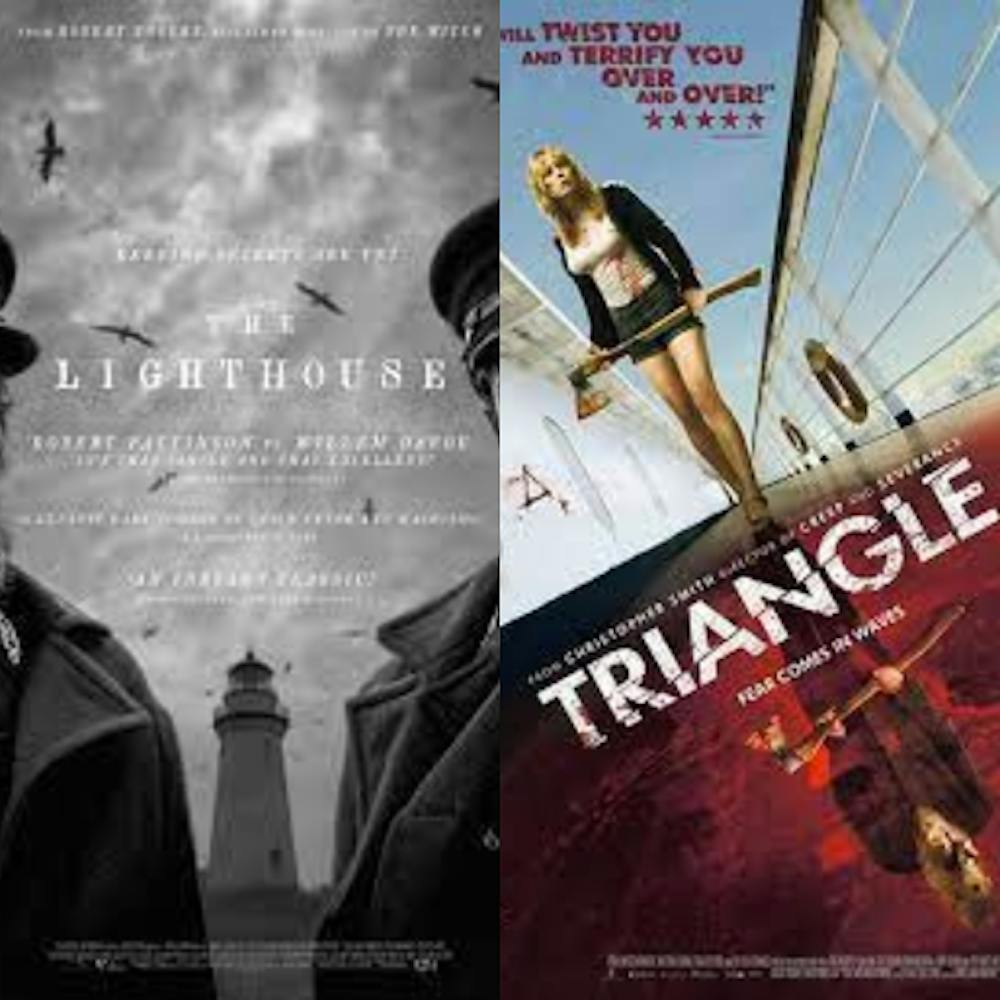By Maia Venuti
Staff Writer
As Halloween gets closer and closer by the day, now is the most seasonally appropriate and festive time to watch horror movies. One of my favorite things to do during the spooky season is to do a double feature of two horror movies that I think pair together really well and compliment one another. These are some of the best double feature combinations to try out this Halloween season.
Nautical horror: “The Lighthouse” (2019) and “Triangle” (2008)
These films, although being filmed a decade apart and being aesthetically opposite, are two of the best films in what I would call the “nautical horror” subgenre. Nautical horror is horror that occurs either by the sea or on the sea, but oceanic elements are central to the story’s plot line.
“The Lighthouse” is a slow-burn period piece about two lighthouse workers, played by Robert Pattinson and Willem Dagoe, who slowly build mistrust towards each other the more time they are stuck manning the lighthouse.
“Triangle” is about a group of friends who went yachting and after severe weather conditions abandon their ship for a larger, more sinister and mysterious ship.
Aside from the nautical elements of these movies, the bigger reason that they pair ever so perfectly together is that they are both retellings of stories from Greek mythology. Both “Triangle” and “The Lighthouse” are phenomenal films that almost feel like they were made to be watched together, despite how different they are.
Revenge horror: “Mandy” (2018) and “A Wounded Fawn” (2022)
Revenge horror is a very difficult genre to do right, and can very easily fall into the formula of “protagonist gets horribly wronged by antagonist, plots revenge and gets revenge.”
“Mandy” and “A Wounded Fawn,” however, take that formula and flip it on its head. “Mandy,” starring Nicolas Cage, is about a couple living in the woods, when tragedy occurs and leads to Cage becoming hellbent on extracting the most brutal revenge on everyone who hurt him.
“A Wounded Fawn” is from the perspective of a serial killer who chooses the wrong victim, leading to a horrible night.
Revenge horror commonly uses a female as the protagonist, with the woman being wronged and needing to take revenge, but these two films are told from a male perspective. Granted, only one of the men in these films is the protagonist, but in “A Wounded Fawn,” you take the point of view of the person worthy of revenge.
Both of these movies do a terrific job of flipping the formula of revenge horror around in a way I had not seen prior to this. While these movies, like most revenge horror, are extremely violent, the films are both unique and bizarre in their own wonderful ways.
Cult/daytime horror: “The Wicker Man” (1973) and “Midsommar” (2019)
Daytime horror seems almost like an oxymoronic statement, as the daytime is usually regarded as a safe time, when nothing or nobody can hurt them.
However, “The Wicker Man” and “Midsommar” eliminate the safety provided by the sunlight. “The Wicker Man” — the original, not the Nicolas Cage remake from 2006 — starring legend Christopher Lee, is a film about a police officer going to investigate the mysterious disappearance of a young girl from a small Scottish island named Summerisle, in which the residents are all pagans.
“Midsommar,” starring Florence Pugh and Jack Reynor, is about a young woman who experiences a massive familial loss and journeys with her boyfriend and his friends to Sweden to observe the midsummer celebrations of a small commune.
Both movies are about cults and take place during a time of festivity in each community and expose the dark underbelly of these communities.
Aesthetically, “The Wicker Man” and “Midsommar” are some of the most beautiful horror movies of all time. The use of daylight highlights the beauty of their surroundings, but also gives characters no place to hide.
The flowery beauty of each movie swallows me whole every time, and these movies just work so perfectly together if you want to get lost in a beautiful nightmare.
Sexuality horror: “It Follows” (2014) and “Teeth” (2007)
Sex is a very common trope used in horror; it is a time when people are extremely vulnerable, and horror plays on that vulnerability. These two films have very unique takes on sex in horror.
“It Follows” is about a teen girl who, after sleeping with her boyfriend, learns that she is the recipient of a curse that is passed through sexual intercourse. Obviously, this film is an allegory for sexually transmitted disease, but it goes so much deeper than just the surface level of how STDs are viewed.
“Teeth” is also about a teenage girl who leads her school’s abstinence club and learns she has teeth somewhere other than her mouth. Without going into too many spoilers, this film is about the importance of consent and the dangers of engaging in sex without it.
Both of these movies do an amazing job at showing sex in horror beyond a young couple making out in a car and getting attacked by a psychotic killer.







